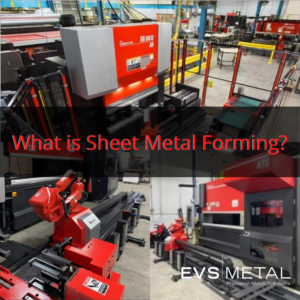We take our work seriously at EVS Metal, and expect our employees to be experts in their fields. Understanding not just how to carry out a process, but how and why that process works is integral to our company’s success. It gives our experienced metalworkers, designers and engineers the freedom to look beyond what’s directly in front of them and instead think creatively in order to troubleshoot or avoid issues altogether.
 Sheet Metal Forming: The Science
Sheet Metal Forming: The Science
Take the science of sheet metal forming, for example. It’s easy to think of it as a simple process; after all, it’s just bending metal, right? Well, yes and no. Metal forming does involve shaping metal materials, but the science behind metal forming is much more nuanced than that explanation. All metal forming is based on the idea that large amounts of stress (ones greater than the yield strength of the material — this is called the proportional limit) are necessary in order to plastically deform metal; in other words, permanently shape it into the desired form. Low amounts of stress may compress or bend metal a bit, but once the force exerting the stress is removed, the material will regain its original shape — much like what happens to a memory foam mattress when the pressure of a body is removed — and the product will become unusable. Additionally, the process of forming cannot include the addition or subtraction of material in order to create a finished product. Essentially, the mass must remain unchanged from start to finish.
Types of Sheet Metal Forming
Sheet metal forming falls into several distinct subcategories, each of which is defined by the difference in the effective stress utilized to shape the metal being formed. These include:
Comprehensive forming:
- Rolling
- Extrusion
- Die forming
- Forging
- Indenting
Tensile forming:
- Stretching
- Expanding
- Recessing
Combined tensile and compressive forming:
- Pulling through a die
- Deep drawing
- Flange forming
- Upset bulging
- Bending
- Shearing
Stress and Strain: Two Crucial Aspects of Sheet Metal Forming
Although stress is generally recognized as the most important factor in sheet metal forming, it should be noted that “strain” is also a crucial element. As more stress is exerted and the metal begins to deform plastically (permanently), it actually becomes stronger. This is both good and bad. Stronger metal is harder and can result in sturdier finished products that can take more wear and tear; but it also means the metal becomes increasingly more difficult to work with, since it is not as pliable as it was at the start. The management of the stress-strain dichotomy throughout the metal forming process is called “flow stress.”
The Impact of Temperature on Forming Processes
The final consideration when working with metal is choosing the temperature at which forming will most effectively occur, as metals react differently depending on whether cold, warm or hot working is chosen. Knowing how different metals perform within each temperature range is essential to successful metal forming outcomes.
Understanding the many complex facets of sheet metal forming detailed above is an important part of our metalworkers’ jobs. As experts, they are trusted to make informed decisions that positively affect our products’ quality. That focus on quality results in satisfied customers, and ultimately carries over to those same customers’ bottom lines.
Find out how EVS Metal’s sheet metal forming experts can add value to your business by requesting a personalized quote online, or by calling (973) 839-4432.





